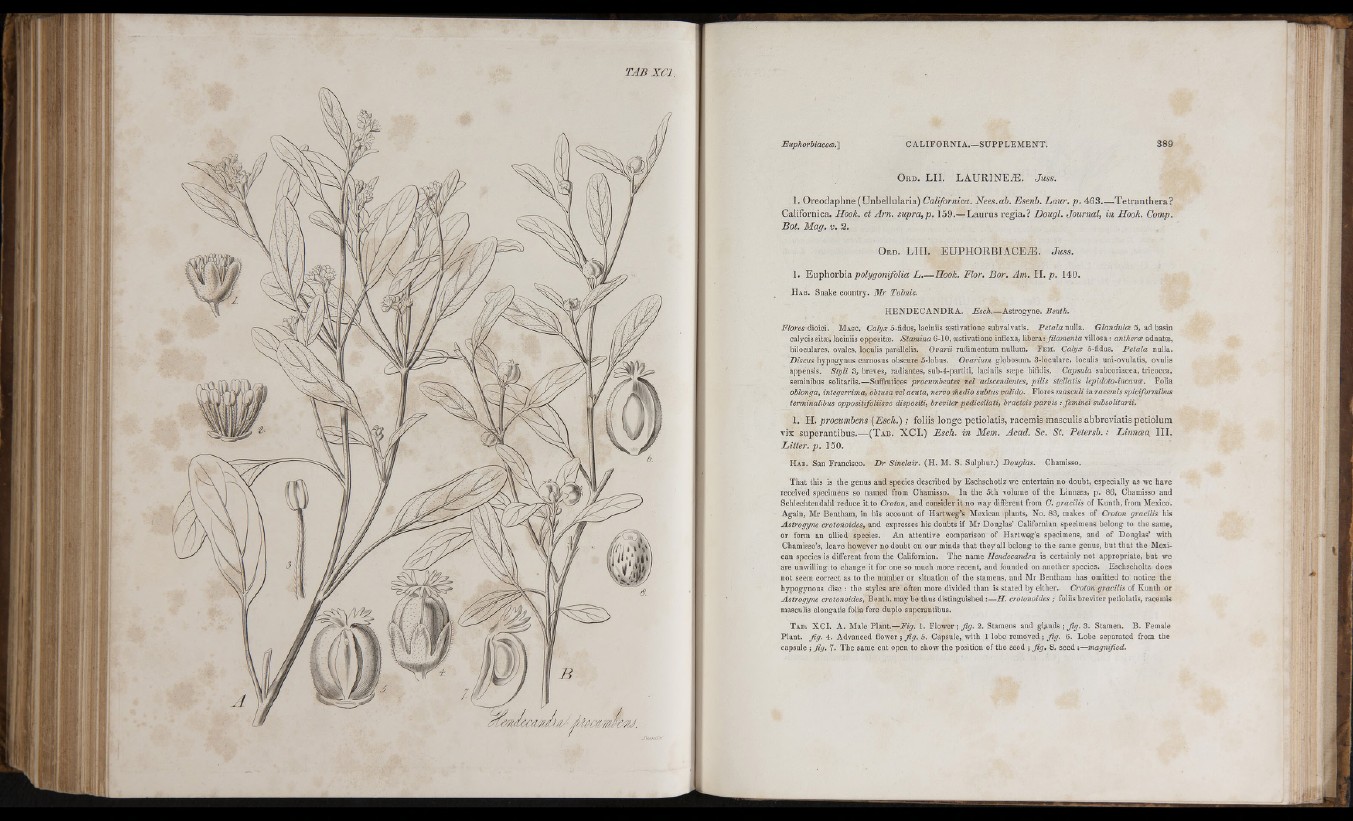
S JÎ! ■
Euphorbiaceoe/] C A L IFO R N IA .—SU PPLEM ENT .
O r d . l i i . L A U R IN EÆ . Juss.
1. Oreodaphne (Unbellularia) Californica. Nees.ab. Esenb. L a u r . p . 46 3— T e tra n th e ra ?
Californica. Hook, et A rn . su p ra ,p . 159.— L au ru s reg ia.? Dougl. Journal, in Hook. Comp.
Bot. Mag. v. 2.
O r d . L I IL E U P H O R B IA C E Æ . Juss.
1. F o fa o rh ia polygonifolia L .— Hook. Flor. B or. Am. I I . p . 140.
H a b . Snake country. Mr Tolmie.
IIENDECAND RA. Æ'scA.—Astrogyne. Benth.
Flores dioici. M as c . Calyx 5-fidus, laciniis æstivatione subvalvatis. Petala nulla. Glandulæ 5, ad basin
calycis sitoe, laciniis oppositæ. Stamina 6-10, æstivatione inflexa, libera: filamenta villosa : antheræ adnatæ,
biloculares, ovales, loculis parallelis. Ovarii rudimentum nullum. F eu . Calyx 5-fidus. Petala nulla.
Discus hypogynus carnosus obscure 5-lobus. Ovarium globosum, 3-locuIare, loculis uni-ovulatis, ovulis
appensis. Styli 3, breves, radiantes, sub-4-partiti, laciniis sæpe bifidis. Capsula subcoriacea, tricocca,
seminibus solitariis.— Suffrutices procumbentes vel adscendentes, p ilis stellatis lepidoto-incana. Folia
oblonga, integerrima, obtusa vel acuta, nervo ■àiedio subtus valido. Flores masculi in racemis spiciformibus
terminalibus oppositifoliisve dispositi, breviter pedicellati, bracteis parvis : feminei subsolitarii.
1. H. procumbens [Esch.) ; foliis longe petiolatis, racemis masculis abbreviatis p etiolum
vix su perantibus (T ab. X C I.) Esch. in Mem. Acad. Sc. St. Petersb.,- Linncea. H I .
L itte r, p . 150.
Hab. San Francisco. D r Sinclair. (H. M. S. Sulphur.) Douglas. Chamisso.
That this is the genus and species described by Eschschotlz we entertain no doubt, especially as we have
received specimens so named from Chamisso. In the 5th volume of the Linnæa, p. 86, Chamisso and
Schlechtendahl reduce it to Croton, and consider it no way different from C. gi-acilis of Kunth, from Mexico.
Again, Mr Bentham, in his account of Hartweg’s Mexican plants, No. 83, makes of Croton gracilis his
Astrogyne crotonoides, and expresses his doubts if Mr Douglas’ Californian specimens belong to tbe same,
or form an allied species. An attentive comparison of Hartwsg’s specimens, and of Douglas’ with
Chamisso’s, leave however no doubt on our minds that they all belong to the same genus, but that the Mexican
species is different from the Californian. The name Hendecandra is certainly not appropriate, but we
are unwilling to change it for one so much more recent, and founded on another species. Eschscholtz does
not seem correct as to the number or situation of the stamens, and Mr Bentham has omitted to notice the
hypogynous disc : the styles are often more divided than is stated by either. Croton gracilis of Kunth or
Astrogyne crotonoides, Benth. may be thus distinguished :—H. crotonoides ; foliis breviter petiolatis, racemis
masculis eiongatis folia fere duplo superantibus.
T a b . XCI. A. Male Plant.—Fé«/. 1. Flower ; Jig. 2. Stamens and gUnds ; fig . 3. Stamen. B. Female
Plant, fig . 4. Advanced flower ; fig . 5. Capsule, with 1 lobe removed ; fig . 6. Lobe separated from the
capsule ; fig . 7. The same cut open to show the position of tbe seed ; Jig, 8. seed :—magnified.